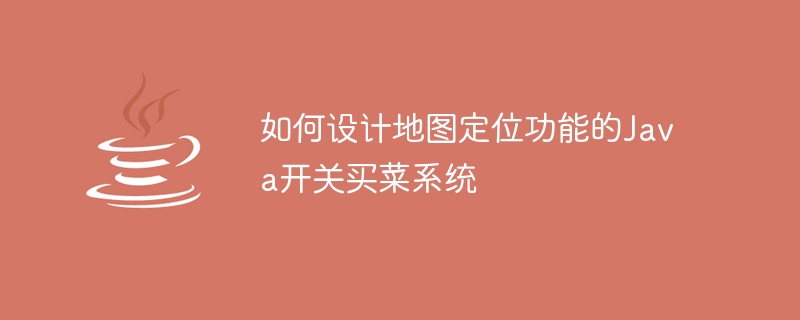Home >Java >javaTutorial >How to design a Java switch grocery shopping system with map positioning function
How to design a Java switch grocery shopping system with map positioning function
- 王林Original
- 2023-11-01 08:50:511487browse

How to design a Java switch grocery shopping system with map positioning function
With the development of Internet technology, online shopping has become an indispensable part of people's lives. The convenience and speed of online shopping have undoubtedly made people’s lives easier. Online shopping platforms provide us with a rich selection of products, and orders are delivered faster and faster. However, although online shopping is convenient, it only meets people's needs for shopping and lacks the process and fun of shopping for groceries. In order to solve this problem, we can design a Java switch food shopping system with map positioning function, so that people can buy food online through mobile APP, and can obtain nearby high-quality food suppliers based on their location. A faster and more convenient grocery shopping experience.
First of all, we need to design a user interface so that users can buy groceries through the mobile APP. Users can browse product categories, prices, reviews and other information in the APP, and can add products to the shopping cart. The shopping cart page should clearly display information about the products the user has selected, including name, quantity, price, etc. In addition, users should also be able to evaluate products and add notes for easy reference by merchants and other users.
Secondly, we need to design a map positioning function so that users can find nearby high-quality food suppliers based on their location. This function can be realized through the positioning module of the mobile phone. Users can open the map in the APP, and the system will automatically locate and display the locations and related information of surrounding businesses. On the map, users can click on the merchant's mark icon to view the merchant's specific information, including merchant name, address, contact information, etc. Users can use this information to choose merchants that are closer to them or that they are more satisfied with to buy groceries.
In order to better serve users, we can also design a merchant evaluation system. Users can evaluate the purchased goods after completing the shopping, including the quality, price and delivery speed of the goods. These reviews can help other users understand the merchant's reputation and service quality, allowing them to make more informed purchasing decisions.
Also, we can add some additional features such as order tracking and quick purchase. Users can know the status of their orders in real time through the order tracking function, including information such as orders received, being shipped, and delivered. The quick purchase function allows users to place orders with one click, avoiding cumbersome shopping processes and saving time and energy.
Finally, we need a backend management system to manage merchant and product information. Merchants can add, edit or delete their own products through the backend system, and can view order information and user reviews. The backend system can also provide merchants with some data analysis and statistical functions to help merchants better understand user needs and make corresponding adjustments and optimizations.
Through the above design, we can implement a Java switch grocery shopping system with convenient map positioning function. Users can easily complete the grocery shopping process through the mobile APP, while enjoying fast delivery and high-quality goods. This system not only facilitates users' lives, but also provides merchants with a broader sales channel and can understand user needs in real time and make corresponding adjustments.
The above is the detailed content of How to design a Java switch grocery shopping system with map positioning function. For more information, please follow other related articles on the PHP Chinese website!

